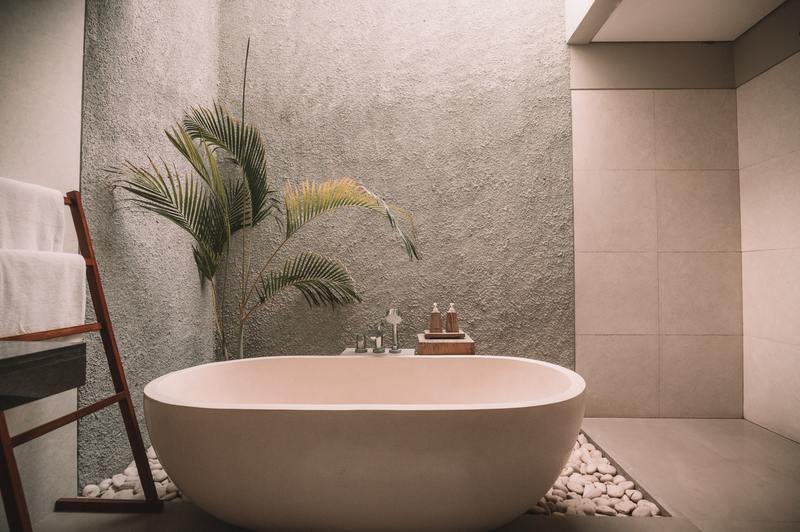Removing the affected plaster is the second step on how to fix water damaged plaster wall beside bathtub. You can read the rest of the instructions below.
We also included how to fix the drywall beside the bathtub. Moreover, we added some tips to manage your bathroom’s moisture, so read until the end!

Steps In Fixing The Plaster Wall Beside Your Bathtub
Seeing discoloration on your plaster walls, especially beside the bathtub, should prompt you to look into your home’s water damage. While you look into it, it’s also recommended that you document the water damage and look into your insurance coverage to know whether your insurance will pay for your repair costs. Ask your lawyer for advice in setting up your insurance claim as well.
Here is an article about dealing with plaster with mold if your plaster has mold and mildew growth.
Step #1. Remove
After looking into the water damage — hopefully with the help of professionals — remove the damaged plaster. Note that you remove the plaster after it has dried.
Once it has properly dried, remove the paint, the plaster coats, and lath. Remove all that have been affected by the water.
Step #2. Clean
After removing the damaged area, wash the affected surface using a sponge and clean water. Then, let it dry.
Step #3. Coat
After letting it dry, prime the area using a quick-dry primer-sealer. Then, fill in the gaps on the plaster wall with a joint compound. Caulk the area near the bathtub as well.
Let it dry and sand down the area if there are bumps. Then, wipe the surface down to remove the dust.
Apply a second coat, fill in the deep and damaged parts, and keep it light on the edges. Remove excess mud and let it dry. Lastly, sand it down and wipe off the dust.
Step #4. Paint
After sanding, prime the surface to prepare it for painting. Use a solvent-based primer-sealer and let it dry. Then, finish the project with paint.
Fixing water-damaged drywall beside the bathtub
The bathroom is a room full of moisture. Unless you have measures to prevent it from having excess humidity, you’re going to have to deal with water damage issues. Since drywall is also a common material for your home’s walls, we also included how to fix water-damaged drywall beside the bathtub.
Step #1. Prepare your materials
The things you will need are the following: a hammer, measuring tape, pry bar, stud finder, utility knife, pencil, carpenter’s square, and level. You will also need a trim, miter saw, finish, nail gun, finishing nails, drill, drywall, drywall screws, drywall tape, drywall mud, drywall mud pan, drywall sanding sheet, and drywall taping knife.
Step #2. Remove
If you change the drywall on the plumbing wall, you have to remove the plumbing fittings. After that, use a hatchet or a drywall hammer to make a hole in the damaged drywall. Make sure that it is large enough that you can fit your gloved hand and grasp the drywall.
Step #3. Cut
Use a razor knife to cut the damaged drywall. Cut them from the vertical corners first, then the horizontal corners.
Rip through the corner tape to remove the affected drywall without affecting the other parts of the walls or the ceiling. Then, grasp the damaged board and pull it away from the wall’s framing.
Step #4. Remove and inspect
If there are remaining fasteners on the framing, remove them using a screw gun or a nail puller. Then, look into the structure and insulation to see if they are water-damaged.
Here is an article about the signs of water damage on insulation. Ensure that the root cause of water damage is fixed before installing new drywall.
Step #5. Measure and mark
Measure the two ends of the vertical corners where the affected drywall was, then mark the new drywall sheet accordingly. After that, cut the drywall with a razor knife on the front side.
Fold the drywall sheet to cut it. Then, be mindful of the “V” created from the fold, and cut the backside through that.
Step #6. Position and fasten
Place the drywall sheet on the wall and leave about a ⅛-inch gap between the tub’s surface and the sheet. Caulk this area.
After that, fasten the sheet with drywall screws with 6-inch intervals on the perimeter. Then, secure at 9-inch intervals on the surface of the drywall sheet. Use fiberglass mesh tape to finish the drywall.
How to manage moisture in the bathroom
Keeping the bathroom free from moisture isn’t that challenging. Just remember to keep it well-ventilated by opening the door and keeping the windows open.
You can also take shorter showers to help you save money from water bills and reduce your bathroom’s humidity. Less water usage can also protect the environment!
Conclusion
Water damage is reasonably typical in bathrooms. However, it does not have to reach the point wherein your structures are unsalvageable. Apart from knowing how to fix water damaged plaster wall beside bathtub, we hope you also learned the tips to ensure that your bathroom doesn’t suffer from too much water damage.
